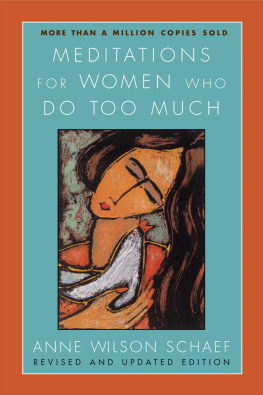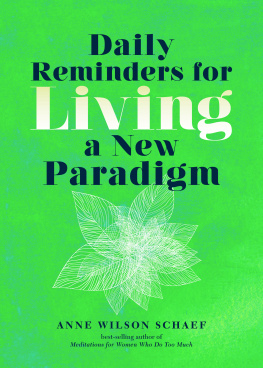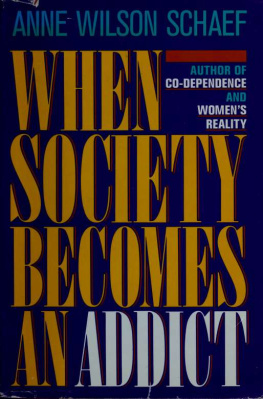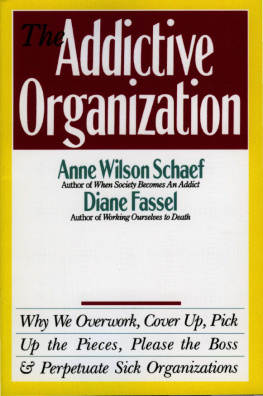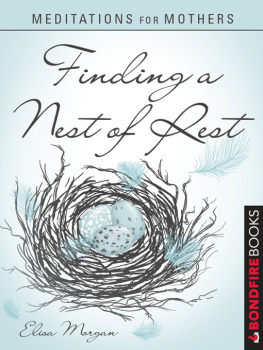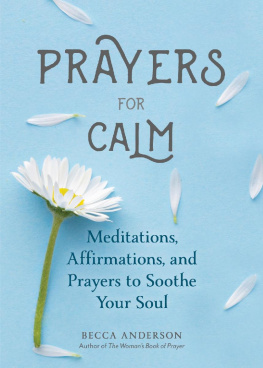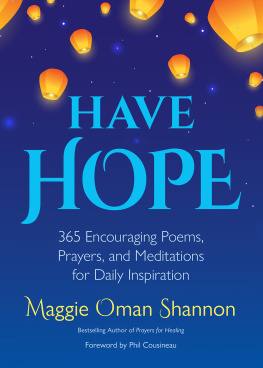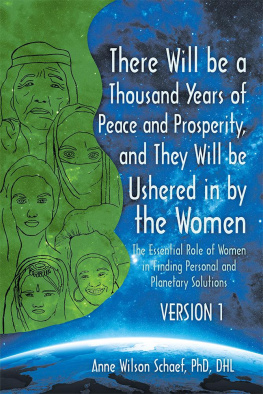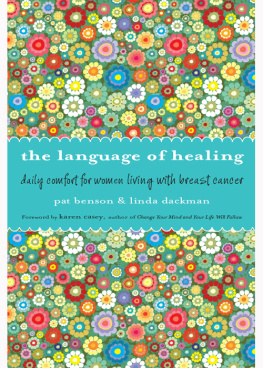Contents
I want to thank so many people who have helped bring this book into being. Let me thank first of all, my agent, Jonathan Lazear, who called one day and said, I have just sold a book you didnt know you were writing. Oh no you havent, I fired back. Then we discussed it. Jan Johnson at Harper & Row was very convincing, and I remembered that way down deep I had always wanted to write a meditation book. I was ready to try my wings on some challenges. So I said yes. I loved the process, and I thank Jan and Jonathan for challenging me.
Then there are the people who backed me up. Many lent support in suggesting quotes, typing, and organizing. Pete Sidley is always there. Ann Sprague did the tedious, time-consuming, and very important work of checking the quotes, checking the typing, making content and editorial changes (as well as personal comments, such as I like this one, Ugh, and so on), and generally helped whip the book into shape. My grown-up kids added the needed peppering of encouragement.
We made a great team. I am more and more convinced that no book ever comes into being through the efforts of only one person. I have had a wonderful time working on this book. It has stretched me as a writer, organizer, and thinker. Most of all I want to thank the wonderful women whose quotes and lives make up the substance of this book, the Twelve Step Program of Alcoholics Anonymous, and the God of my understanding.
This is a meditation book for women who do too much. When my publishers first suggested doing this book, we talked of the need for a book for women work-aholics. Yet, as we discussed the need for such a book, we began to explore the many different kinds of women who overwork and do too much and agreed that many of us would not initially define ourselves as workaholics. However, there are many of us who do too much, keep too busy, spend all our time taking care of others and, in general, do not take care of ourselves. Many of us have crossed over the line to compulsive, addictive, self-defeating behavior and need to make some major changes in our lives. Hence, I decided to write a book for women who do too much regardless of where we do it or how we do it. This is a book for women workaholics, busyaholics, rush-aholics, and careaholics. I hope that it will prove interesting, challenging, and helpful to a range of women.
I decided to use only quotes from women. This does not mean that there are no tempting, exciting, and usable quotes from menthere are. However, I found so many wonderful quotes from women that I decided to use them exclusively. I have used a variety of quotes from women. I have tried to use quotes from women of different ages, cultures, disciplines, and perspectives. I have used quotes from famous women, women at intensives, and women who just said something important in passing. This gathering of womens quotes has proved to be a rich and enriching experience for me.
In preparation for this book, I returned to several novels by and about women that I had read in the sixties and seventies. What a wonderful rediscovery! I met old friends (the heroines) who had rested dormant in my soul and again came alive as I returned to them. Some of them re-emerge on these pages. I hope you enjoy them as much as I did.
This book of meditations is not only for women, even though it is written from a womans perspective, in the female idiom, and is viewed through the eyes of women. Several men have read the manuscript and found it very helpful. I am happy to share these meditations with anyone who finds them useful. I know that there are many of us who are working ourselves to death and still not making our contribution. Life does not have to be that way.
In some ways this book follows a usual form for meditations and in others not. There is a meditation for each day of the year. Each day begins with a quotation, which is followed by a meditation on it, and ends with a few words for the day. Since I assumed women who do too much would not take much time for meditations (and probably usually take none!), I tried to make each meditation brief. In addition, I have added several extra meditations at the end of the book. If you do not respond to one on a particular day, look at one of the extras.
These meditations do not tell you what to do, they do not tell you how you should be, and they are not answers. They are intended to stir up some feelings, get you thinking, and precipitate possibilities for change that will add to the quality and vitality of your life. These meditations can be experienced as an open door or as a direct hit to the solar plexus. Make of them what you will.
It is with great pleasure that I introduce this new revised edition of Meditations for Women Who Do Too Much . The original book, published in 1990, was an instant success and sold over two million in the United States alone. That edition has been translated into many, many languages and has proved to be a bestseller throughout the world. It hit a nerve! If there is anything that women the world over have in commoncrossing racial, religious, socioeconomic, and social linesit is that we all do too much. We have been described as workaholics, careaholics, rushaholics, and busyaholics, and we are often so busy and distracted that we forget to take care of ourselves. Most of us would not describe ourselves as one of the aholics and almost all of us would agree that we quite simply do too much. Doing too much seems to be a given for most women.
How long have we known about this phenomenon? A long time. Florence Nightingale, who died in 1910, said, Women never have a half-hour in all their lives (except before or after anybody is up in the house) that they can call their own, without fear of offending or of hurting someone. Why do people sit up so late, or, more rarely, get up so early? Not because the day is not long enough, but because they have no time in the day themselves.
In the eighties and nineties we talked about workaholism, careaholism (co-dependence and Al-Anon), rushaholism, and busyaholism, and some were helped by working a twelve-step program. We defined workaholism as the addiction of choice of the unworthy. A little earlier (1960s and 1970s) women had tackled the subtle yet intense cultural brainwashing acculturation that had convinced us at a very deep, often unconscious level that we were, indeed, undeserving and unworthy in the eyes of the culture and suffered from The Original Sin of Being Born Female (discussed in Womens Reality [1981]). Some of us had hoped that after all that consciousness raising there would be major shifts in the way we women lived, worked, and thought of ourselves. Some changes have certainly occurred and we have shifted internally as women. Yet, as we moved into the jobs that men have traditionally held and into the new millennium, we were still doing too much. We had just added new professional responsibilities to the tasks women were already doing within a stepped-up society, where intensity and two-profession families are the norm not the exception. Even more is expected of us women, and we make great demands upon ourselves.
We have also developed some new labels to describe our lives. We now talk about multi-tasking. Women have been multi-tasking for centuries, yet, with a new label one can be fooled into believing it is a new phenomenon. And the illusion of a new phenomenon allows us to deny the pressure of long-range, un-dealt-with problems. In fact, it would be interesting to speculate on the many repercussions of the phenomenon of renaming and making something that has traditionally been destructive a new problem. Doing too much is not a new phenomenon and it continues to be a problem we women face every day. We are stretched thinner and thinner as we try to cope with our lives and make them productive, meaningful, and fun for ourselves and others.

